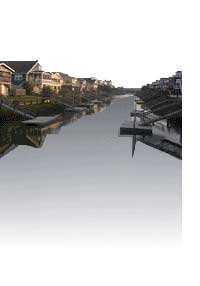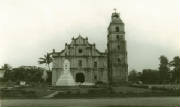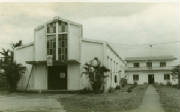 |
 |
 |
 |
|
OFM ARCHIVES - PHILIPPINES
|
 |
|
The Franciscans in Cagayan Valley
|
 |
|
|

|
| St. Anne Parish, Buguey, Cagayan Valley |
HISTORY OF THE PARISH OF BUGUEY, CAGAYAN
By:
Fr. Martino Concato, OFM
According
to Fr. Francisco Rojano, a great chronicler of Cagayan, the first conquistadores arrive in this province came through a lagoon
near the town of Buguey named Cagayan, which gave the name
to this province as well as to the natives living there.
The
Spaniards set foot in Buguey soon after they founded Nueva Segovia ( Lalloc). The
Dominicans took over its administration, during their Chapter held on June 15, 1596, under the patronage of St. Vincent Ferrer,
which in the chapter held on May 20, 1623, was changed to that of Sta. Ana until
the present.
It
is not know where the etymology of Buguey comes from. Perhaps it makes reference
to the frequent shipwrecks that used to take place in its shores near the mouth of the Cagayan river. Such is the opinion of Fr. Antonio Lobato who, in his dictionary, writes under the word Buguey: to sink,
to be shipwrecked.
In
the year 1616, Don Juan de Silva, Governor General, granted permission to build a church and a convent. In 1617, Don Antonio de Valtierra was the encomendero. According
to Fr. Rojano, in 1732 the church and the convent were destroyed by fire caused by a vigil lamp that was burning in one of
the rooms. It was a pity to see the best around go up in flames.
The
Dominicans were in Buguey till 1897 when the American took over the government of the Philippine Islands and the secular priest
s, the spiritual care of the people.
During
World War II the convent was burned down – its ruins can still be seen.
Fr.
Gerardo Filippetto and Fr. Angelo Ramponi arrived in March of 1952 and took over the administration of the parish from the
last Filipino secular priest, Fr. Francisco Boado. They also stated the Italian
Franciscan Foundation of Cagayan.
During
the last 26 years the parish was reorganized both spiritually and materially. Spiritually,
by the increased assistance given to the barrio folks, bringing to them the Mass
and the sacraments. Parish organizations were reorganized and increased; religious
instruction begun to be imparted in all public schools. Materially, by the improvements
done in the convent and church: the convento was enlarged; the church walls were plastered, the roofing was replaced, and
a new granolithic floor was laid.
At
present, the parish is served by two priest: Fr. Antonino Sernagiotto, OFM parish
priest, and Fr. Martino Concato, OFM, regular superior, vicar forane and member of the Diocesan Council of Priests.
In
Febrauary 1978, the fraternity of the Third Order was recognized. Fr. Bernardine
Leones, OFM, Natinal Spiritual
Director of the Third Order, was in Buguey for the occasion and talked to the Tertiaries about the Franciscans spirituality.
IV
Centenial Activities
On
July 10, 1978, the Bugueyanos held an impromptu program to welcome the rev. Fr. Ezechiele Danieli, OFM, the Provincial of the Venetian Province. In
the course of the program the people thanked Fr. Provincial again and again for having sent the Franciscans to Cagayan. They also expressed their deep gratitude to all the Franciscans who have worked here
and expressed their wishes that young Filipino Franciscans continue working here.
On
September 10, 1978, the Very Rev. Fr. Silvestre Murillo, vicar, visited the Cagayan foundation.
He met with the Tertiaries and talked to them at length about the history of the Franciscan Order, particularly in
the Philippines. He expressed satisfaction for the many vocations to
the Order here in the Philippines; our house of formation are filled with candidates, some of whom hail from Cagayan. This is indeed good news to hear during the fourth centennial
celebration.
____ 400 Years 1578 -1978 FFRANCISCANS IN THE PHILIPPINES
|
|

|
| St. Anthony Parish, Santa Ana, Cagayan |
St. Anthony
Parish
Santa Ana, Cagayan
Located at the north eastern tip of Luzon in the
Province of Cagayan,
practically it is the last town in the North. It was formerly the barrio Palawig, Gonzaga, Cagayan Valley, Proclaimed town by Executive
Order #. 239 by President Quirino on October 21, 1949, with a new name: SANTA ANA, derived from the first letters of the family
names of the provincial officers, A- Governor Nicasio Arranza, N – Board Member Federico Navarro and A- Board Member
Roberto Avena. The former “Palawig” was attended by the Diocesan
Clergy from Buguey until 1948 when it was entrusted to the priest residing in Gonzaga.
In March 1952 the Franciscan Fathers from the Franciscan Province of St. Anthony of Padua
in Venice, Italy
arrived in the newly created municipality. Ecclesiastically it was still a part of the Parish of Gonzaga, with Fr. Salvador
Lazo. Become an independent religious entity in 1954 base on the four parish
records of baptisms, confirmations, marriages and funerals. Fr. Gerardo “Gerry”
Filippetto , OFM was the first parish priest.
At Present, the Christian community of Sta. Ana
is growing, as evidenced by the activity and involvement of the different parish organizations and the Catholic Education
imparted by the St. Anthony College formerly St.
Anthony Academy was founded February 14,
1953.

|
| St. Rock Parish Hall , Gonzaga, Cagayan |
PARISH
OF SAINT ROCK
Gonzaga,
Cagayan
Valley
Wangag was the town imposingly faces the Babuyan
Channel on the Northeastern tip of Cagayan that was officially established as municipality in 1917and was change to Gonzaga
in honor of the first Governor of Cagayan, Don Gracio Gonzaga; with the lot area
of 560 sq. (m/km.?). 1980 the census population recorded 22,000 papules. Farming, fishing, cattle and forest product are their
main sources of livelihood. It is also rich in natural resources such as, iron, gold and lime stone. Ecclesiastical record shows that the parish started/ founded in 1948,
Fr. Roque Pagulayan was the first parish priest, followed by Fr. Salvador Lazaro and on July to August of 1952 the first Franciscan
serve as parish priest was Fr. Angelo Ramponi, OFM, Fr. Martino Concato, OFM from
September 1952 to December 1953, Fr. Carmelo Paludetti, OFM January 1954 to July 1962, Fr. Antonino Sernagiotto, OFM July
1962 to December 1975, Fr. Giovanni Piva, OFM December 1975, and Fr. Benito Claveria,
OFM the last Franciscan Parish Priest. The Franciscan mission ended in Gonzaga on1990. The Diocese took over.

|
| St. Mary of the Angels Parish Sta. Teresita, Cagayan Valley |
St. Mary
of the Angels Parish
Sta. Teresita,
Cagayan
“Namunit” was formerly a big barrio
of Buguey. In 1965 it was separate
town and municipality and was given a new name of “Sta. Teresita” not in honor of the saints but in the name of
the incumbent Governor of Cagayan at that time , Teresa J. Dupaya.
In1965-68, Sta. Teresita continued to be a part
of the Parish of Buguey, with regular Sunday service in its old barrios chapel conducted by Fr. Fortunato de Pellegrin, OFM.
On 1969 it became a “quasi-parish, with
Fr. Pelligrin as the resident pastor. 1971, the brothers started the construction
of the Parish Church. Fr. Fortunato left for Italy and
Fr. Giuseppe Prandina, OFM took over as “quasi-parocus”.1972,
Holy week the church was finished and open to public worship. It was pronounced as parish under the patronage of St. Mary
of the Angels, on 1973 with Fr. Giovanni Piva, OFM as the first parish priest. It was assigned to the Franciscans as perpetuum.
Officially, the parish encompasses the whole Sta. Teresita Municipality
with its thirteen (13) barrios. It is among the smallest town of Cagayan; it lies with Buguey, Gonzaga and Sta. Ana in the northeastern tip of the province,
along the coast of the Babuyan Channel. Sits between Gonzaga to the east and
Buguey to the west; with a natural boundary, the Mission River that separate it from Gonzaga. The total land area is 80 sq. kilometer. Classified
as follows: agricultural, residential, Commercial, institutional, Forest. The 95% of the People are Ilocanos the others are
Itawis, Bicolano, Visaya, Ibanags, Aetas or Negritos among the hills bordering
the town. Farming is the basic source of income.
|
 |
 |
 |
|
|
 |
|
|
 |
|
|
|
|
